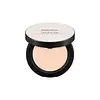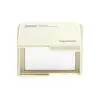What's inside
What's inside
 Key Ingredients
Key Ingredients

 Benefits
Benefits

 Concerns
Concerns

 Ingredients Side-by-side
Ingredients Side-by-side

Talc
AbrasiveMica
Cosmetic ColorantCaprylic/Capric Triglyceride
MaskingPolymethyl Methacrylate
Silica
AbrasiveHdi/PPG/Polycaprolactone Crosspolymer
Phenyl Trimethicone
Skin ConditioningDimethicone
EmollientTriethoxycaprylylsilane
Octyldodecyl Stearoyl Stearate
Emollient1,2-Hexanediol
Skin ConditioningGlyceryl Caprylate
EmollientCI 77491
Cosmetic ColorantMethicone
EmollientHydrogenated Lecithin
EmulsifyingCI 77492
Cosmetic ColorantParfum
MaskingCalamine
AbsorbentHouttuynia Cordata Powder
Skin ConditioningCI 77499
Cosmetic ColorantWater
Skin ConditioningButylene Glycol
HumectantMentha Arvensis Leaf Extract
MaskingTalc, Mica, Caprylic/Capric Triglyceride, Polymethyl Methacrylate, Silica, Hdi/PPG/Polycaprolactone Crosspolymer, Phenyl Trimethicone, Dimethicone, Triethoxycaprylylsilane, Octyldodecyl Stearoyl Stearate, 1,2-Hexanediol, Glyceryl Caprylate, CI 77491, Methicone, Hydrogenated Lecithin, CI 77492, Parfum, Calamine, Houttuynia Cordata Powder, CI 77499, Water, Butylene Glycol, Mentha Arvensis Leaf Extract
Mica
Cosmetic ColorantSynthetic Fluorphlogopite
Silica
AbrasiveDimethicone
EmollientMacadamia Ternifolia Seed Oil
EmollientHdi/PPG/Polycaprolactone Crosspolymer
Glycerin
HumectantMagnesium Myristate
Isopropyl Palmitate
EmollientPentylene Glycol
Skin ConditioningMoringa Oleifera Seed Oil
EmollientButyrospermum Parkii Butter
Skin ConditioningEnantia Chlorantha Bark Extract
Skin ConditioningPearl Extract
AntioxidantCandida Bombicola/Glucose/Methyl Rapeseedate Ferment
AntimicrobialDiamond Powder
AbrasiveTriethoxycaprylylsilane
Polysorbate 20
EmulsifyingOctyldodecyl Stearoyl Stearate
EmollientAcrylamide/Sodium Acryloyldimethyltaurate Copolymer
Emulsion StabilisingMagnesium Aluminum Silicate
AbsorbentHydrogen Dimethicone
Sorbitan Olivate
EmulsifyingSorbitan Stearate
EmulsifyingIsohexadecane
EmollientEthylhexylglycerin
Skin ConditioningPolysorbate 80
EmulsifyingSorbitan Oleate
EmulsifyingButylene Glycol
HumectantPropylene Glycol
HumectantPolymethylsilsesquioxane
Octyldodecanol
EmollientCeramide NP
Skin ConditioningPhytosphingosine
Skin ConditioningHydrogenated Lecithin
EmulsifyingTocopherol
AntioxidantGlycine Soja Sterols
EmollientOleanolic Acid
Skin ConditioningOleyl Alcohol
EmollientPhenoxyethanol
PreservativeSodium Dehydroacetate
PreservativePotassium Sorbate
PreservativeParfum
MaskingBenzyl Alcohol
PerfumingCitronellol
PerfumingBenzyl Benzoate
AntimicrobialCoumarin
PerfumingGeraniol
PerfumingAmyl Cinnamal
PerfumingLinalool
PerfumingLimonene
PerfumingAlpha-Isomethyl Ionone
PerfumingMica, Synthetic Fluorphlogopite, Silica, Dimethicone, Macadamia Ternifolia Seed Oil, Hdi/PPG/Polycaprolactone Crosspolymer, Glycerin, Magnesium Myristate, Isopropyl Palmitate, Pentylene Glycol, Moringa Oleifera Seed Oil, Butyrospermum Parkii Butter, Enantia Chlorantha Bark Extract, Pearl Extract, Candida Bombicola/Glucose/Methyl Rapeseedate Ferment, Diamond Powder, Triethoxycaprylylsilane, Polysorbate 20, Octyldodecyl Stearoyl Stearate, Acrylamide/Sodium Acryloyldimethyltaurate Copolymer, Magnesium Aluminum Silicate, Hydrogen Dimethicone, Sorbitan Olivate, Sorbitan Stearate, Isohexadecane, Ethylhexylglycerin, Polysorbate 80, Sorbitan Oleate, Butylene Glycol, Propylene Glycol, Polymethylsilsesquioxane, Octyldodecanol, Ceramide NP, Phytosphingosine, Hydrogenated Lecithin, Tocopherol, Glycine Soja Sterols, Oleanolic Acid, Oleyl Alcohol, Phenoxyethanol, Sodium Dehydroacetate, Potassium Sorbate, Parfum, Benzyl Alcohol, Citronellol, Benzyl Benzoate, Coumarin, Geraniol, Amyl Cinnamal, Linalool, Limonene, Alpha-Isomethyl Ionone
Ingredients Explained
These ingredients are found in both products.
Ingredients higher up in an ingredient list are typically present in a larger amount.
Butylene Glycol (or BG) is used within cosmetic products for a few different reasons:
Overall, Butylene Glycol is a safe and well-rounded ingredient that works well with other ingredients.
Though this ingredient works well with most skin types, some people with sensitive skin may experience a reaction such as allergic rashes, closed comedones, or itchiness.
Learn more about Butylene GlycolDimethicone is a type of synthetic silicone created from natural materials such as quartz.
What it does:
Dimethicone comes in different viscosities:
Depending on the viscosity, dimethicone has different properties.
Ingredients lists don't always show which type is used, so we recommend reaching out to the brand if you have questions about the viscosity.
This ingredient is unlikely to cause irritation because it does not get absorbed into skin. However, people with silicone allergies should be careful about using this ingredient.
Note: Dimethicone may contribute to pilling. This is because it is not oil or water soluble, so pilling may occur when layered with products. When mixed with heavy oils in a formula, the outcome is also quite greasy.
Learn more about DimethiconeWe don't have a description for Hdi/PPG/Polycaprolactone Crosspolymer yet.
Hydrogenated Lecithin is created from the hydrogenation of lecithin (a group of phospholipids). Hydrogenation is a chemical reaction between hydrogen and another element.
This ingredient is an emollient and emulsifier. As an emollient, it helps soften skin by trapping moisture within. As an emulsifier, it prevents oil and water ingredients from separating.
Mica is a naturally occurring mineral used to add shimmer and color in cosmetics. It can also help improve the texture of a product or give it an opaque, white/silver color.
Serecite is the name for very fine but ragged grains of mica.
This ingredient is often coated with metal oxides like titanium dioxide. Trace amounts of heavy metals may be found in mica, but these metals are not harmful in our personal products.
Mica has been used since prehistoric times throughout the world. Ancient Egyptian, Indian, Greek, Roman, Aztec, and Chinese civilizations have used mica.
Learn more about MicaOctyldodecyl Stearoyl Stearate is created from stearic acid.
It is an emollient and thickens the lipid (oil) portion of a product. Due to its emollient properties, it may not be fungal-acne safe.
Parfum is a catch-all term for an ingredient or more that is used to give a scent to products.
Also called "fragrance", this ingredient can be a blend of hundreds of chemicals or plant oils. This means every product with "fragrance" or "parfum" in the ingredients list is a different mixture.
For instance, Habanolide is a proprietary trade name for a specific aroma chemical. When used as a fragrance ingredient in cosmetics, most aroma chemicals fall under the broad labeling category of “FRAGRANCE” or “PARFUM” according to EU and US regulations.
The term 'parfum' or 'fragrance' is not regulated in many countries. In many cases, it is up to the brand to define this term.
For instance, many brands choose to label themselves as "fragrance-free" because they are not using synthetic fragrances. However, their products may still contain ingredients such as essential oils that are considered a fragrance by INCI standards.
One example is Calendula flower extract. Calendula is an essential oil that still imparts a scent or 'fragrance'.
Depending on the blend, the ingredients in the mixture can cause allergies and sensitivities on the skin. Some ingredients that are known EU allergens include linalool and citronellol.
Parfum can also be used to mask or cover an unpleasant scent.
The bottom line is: not all fragrances/parfum/ingredients are created equally. If you are worried about fragrances, we recommend taking a closer look at an ingredient. And of course, we always recommend speaking with a professional.
Learn more about ParfumSilica, also known as silicon dioxide, is a naturally occurring mineral. It is used as a fine, spherical, and porous powder in cosmetics.
Though it has exfoliant properties, the function of silica varies depending on the product.
The unique structure of silica enhances the spreadability and adds smoothness, making it a great texture enhancer.
It is also used as an active carrier, emulsifier, and mattifier due to its ability to absorb excess oil.
In some products, tiny microneedles called spicules are made from silica or hydrolyzed sponge. When you rub them in, they lightly polish away dead skin layers and enhance the penetration of active ingredients.
Learn more about SilicaTriethoxycaprylylsilane is a silicone used to bind and stabilize ingredients.
As an emulsifier, it helps prevent ingredients from separating. This can help elongate the shelf life of products.
Triethoxycaprylylsilane is often used to coat mineral sunscreens ingredients to help give a better feel. It also helps reduce oxidative stress in sunscreens.
Learn more about Triethoxycaprylylsilane